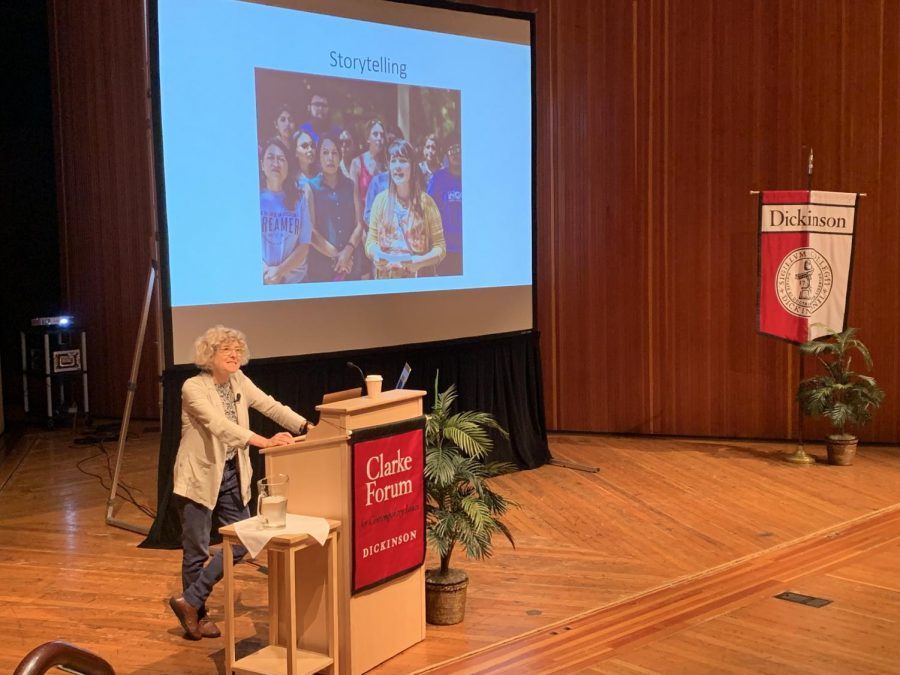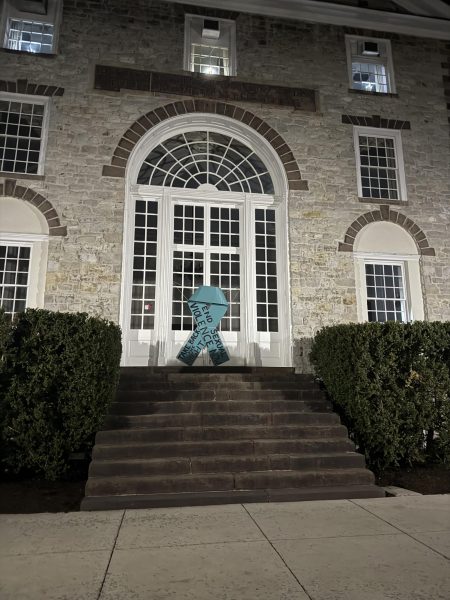Speaker Argues “America Woke Up in Arizona”
Professor of Law Kathryn Abrams from University of California, Berkley spoke about her research on strategies that undocumented peoples have utilized to create an extremely robust movement.
She opened her lecture with the description of four undocumented immigrants in Phoenix, Arizona, standing outside of a federal courthouse with American former law enforcement officer and politician Joe Arpaio inside, who had been charged with constitutional violations for the racial profiling of Latinos. At this demonstration, they presented statements, unfurled a banner saying “Sin Papeles, Sin Miedo” (Without Papers, Without Fear), placed it on the middle of the street and sat on each of the four corners awaiting arrest.
Abrams was struck by this scene of undocumented immigrants protesting. She contrasted it with how, in [American] culture, protest and social activity are associated with citizens. In addition, she pointed out the difficult environment that these undocumented immigrants were organizing and practicing civil disobedience in. Arizona is infamous for its restrictive anti-illegal immigration measures, such as attrition through enforcement, a process to make undocumented immigrants so unwelcome that they would self-deport to their countries of origin, and SB 1070, a statue that criminalized undocumented presence and employment and authorized law enforcement officers to demand required immigration documents of any individual above 18, according to Abrams.
For her research, Abrams observed organizations in Phoenix, Arizona and conducted 100 semi-structured interviews with activists, some allies and officials and studied media/social media coverage. She proposed three central practices that those organizations used to transform undocumented immigrants into activists.
She first introduced storytelling. As undocumented community members struggled with the ambiguous nature of their status, sharing stories fought the internalized stigma produced by anti-immigrant politics, created new associations with being undocumented and demonstrated what they have accomplished despite obstacles encountered. Abrams explained how storytelling also allowed bonds to be formed between undocumented community members that are crucial to their participation and gave them practice into self-narration and the sharing of difficult emotions and prepared members for outward-facing activism. Stories were presented as the best way to persuade and emotionally connect with an audience.
Abrams mentioned the creation of robust emotion cultures as a tactic to foster mobilizing emotions and to fight demobilizing emotions that might make activism difficult. One method included creating emotional environments in which new participants are supported with encouraging words, touches and finger snaps. She also discussed language-based strategies that helped new participants interpret their negative feelings in positive ways, such as aphorisms like “working outside your comfort zone is the way that you grow” or emotives [emotional expressions] such as “we are undocumented and unafraid” that connect an empowering emotional state with an identity that they have accepted. Other organizational strategies Abrams brought up included celebrating small victories and extending time horizons for progress.
The final strategy that Abrams presented was performative citizenship. She used the involvement of undocumented youth in civic engagement campaigns to increase the voter registration and turnout of Latino citizens and allies as an example of institutional participation. Others engaged in oppositional participation, such as participation in a march, directed action to demand accountability by elected representatives and civil disobedience. In addition, since the assertion of rights is a central prerogative of citizens, know-your-rights trainings helped mobilize undocumented immigrants to a more rights-based procedure when facing law enforcement. Abrams explained that these actions placed undocumented people in political roles that the public might understand as defining citizens and citizenship.
The presentation was overall very positively received by students and professors. Tierney McCue ’20 enjoyed Professor Abrams’ “observations on effective actions taken, at great peril, [by] undocumented immigrant activists in Phoenix,” she said and continued that she was “inspired by the work that these teens and young adults have [done] as they canvas throughout the area to get people to vote, even though they are denied [the right] to do so.” Assistant Professor of Philosophy Amy McKiernan said she “appreciated her focus on the value of emotional modeling and emotion culture in the undocumented immigrants’ movement” and was impressed by her engaging
presentation style and the questions asked by Dickinson students afterwards. Director of the Office of Equity and Inclusivity and Executive Director of the Women’s and Gender Resource Center Donna Bickford appreciated the timeliness of the research and how Abrams “[stressed] the courage it takes for undocumented immigrants to speak out, given the risk of apprehension/detention, as well as noting the strength and resiliency they exhibit,” she said. Bickford continued that it was also powerful when, during the Q&A section of the program, [Abrams] discussed both the “contributions and limitations of her role as a (white) participant-observer.”
Abrams pointed out that these strategies have created a highly organized, increasingly recognized and supported movement in Arizona, and have even served undocumented immigrant movements after the 2016 election of President Donald Trump. She concluded with a quote from one of the undocumented immigrants she spoke to, that “America woke up in Arizona.”
“Storytelling, Emotion Culture, and Performative Citizenship in the Undocumented Immigrants Movement,” took place on Thursday, Sept. 26 at 7:00 p.m. in ATS.






